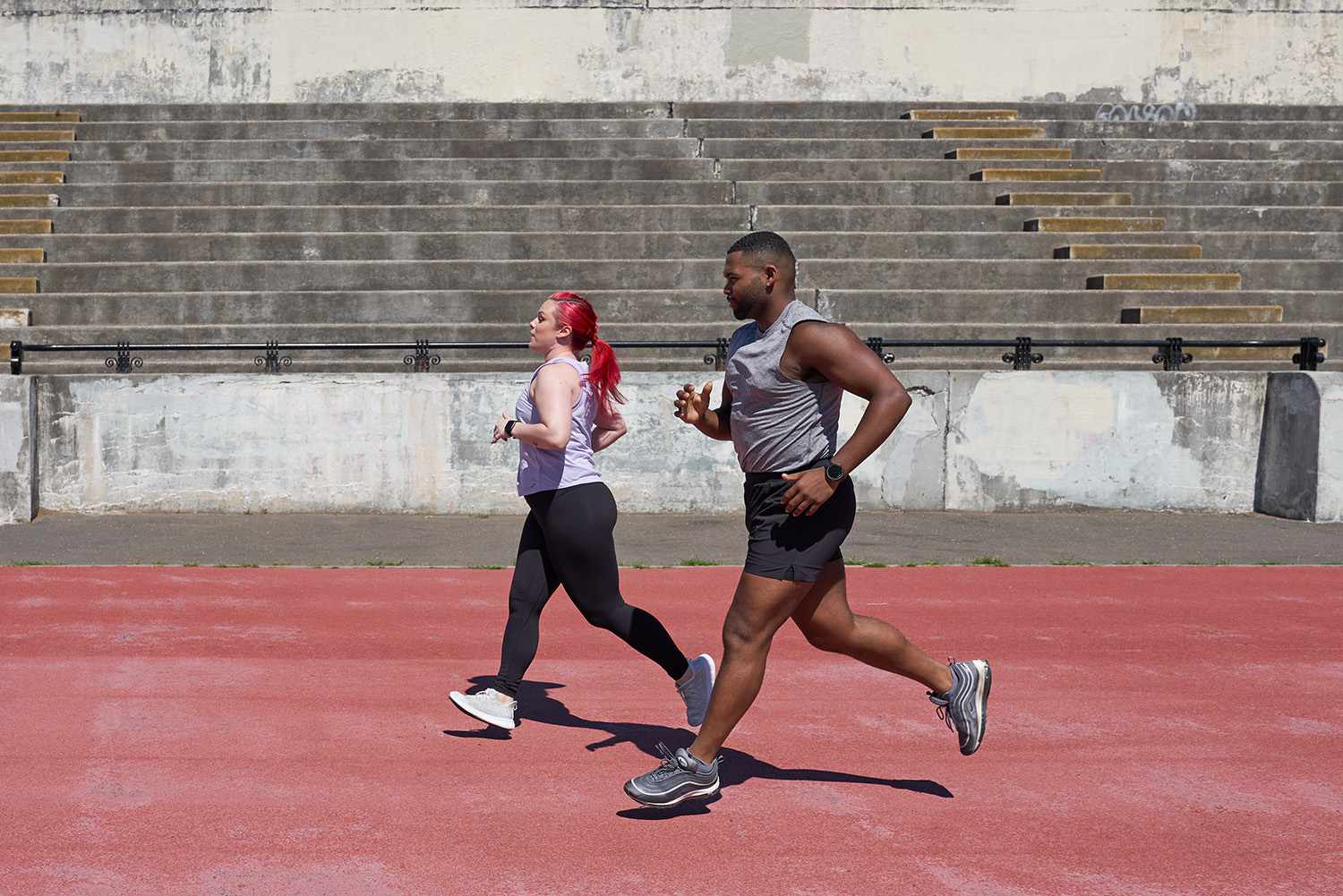Home>Misc>Featured>How Long Does It Take To Train For 10K Run


Featured
How Long Does It Take To Train For 10K Run
Modified: August 21, 2023
Get ready to take on a 10K run! Discover how long it takes to train and prepare for this featured event and achieve your running goals.
Introduction
So, you’ve decided to take on the challenge of running a 10K race. Congratulations! Training for a 10K requires dedication, perseverance, and a well-thought-out plan. Whether you’re a seasoned runner looking to improve your time or a beginner taking on their first race, this article will guide you through the process of training for a 10K run.
A 10K race, also known as a 10-kilometer race, is a popular distance for both beginner and experienced runners. It offers a perfect balance of endurance and speed, pushing your limits without being too overwhelming. Completing a 10K race is a significant achievement and can serve as a stepping stone to longer distances like half marathons or marathons.
Before diving into the training plan, it’s important to note that the time it takes to train for a 10K can vary depending on your current fitness level, running experience, and overall health. Some may need a few weeks to prepare, while others may require several months. It’s essential to listen to your body and gradually increase your training intensity to avoid overexertion and injuries.
In this article, we will discuss the key aspects of training for a 10K race. We’ll explore setting a goal, creating a training plan, building endurance, increasing mileage, incorporating speed work, strength training, rest and recovery, nutrition and hydration, monitoring progress, avoiding common injuries, and mental preparation. By following these guidelines, you’ll be well-prepared to conquer the 10K distance and achieve your personal best.
Now, let’s dive into the details of each step and embark on this exciting journey towards completing the 10K race.
Setting a Goal
Before starting your 10K training, it’s crucial to set a clear and achievable goal. Setting a goal will not only give you motivation throughout the training but also help you structure your training plan effectively.
The first step in setting a goal is to determine your desired outcome. Do you want to complete the race? Improve your previous 10K time? Or maybe aim for a specific finishing time? Having a clear goal in mind will provide you with a sense of purpose and focus during your training.
Once you’ve established your goal, it’s important to make it realistic and attainable. Consider factors such as your current fitness level, previous running experience, and the time frame in which you plan to train. Assigning a specific time or performance goal can be a great way to motivate yourself, but also be realistic about what you can achieve given your circumstances.
Another aspect to consider when setting a goal is to break it down into smaller milestones. This approach helps to alleviate the pressure of reaching a big goal all at once. For example, you can set short-term goals such as running a certain distance without stopping or improving your pace by a specific percentage. These mini milestones will keep you motivated and give you a sense of achievement along the way.
Lastly, it’s essential to make your goals measurable. Having tangible metrics allows you to track your progress and make adjustments to your training plan if needed. Whether it’s tracking your running times, distances, or heart rate, having quantifiable data will help you stay on track and evaluate your progress.
By setting clear, achievable, and measurable goals, you’ll have a roadmap to follow during your 10K training. Remember, your goals should be personal to you and align with your capabilities. With a vision in mind, you can now move forward to the next step: creating a training plan that will bring you closer to your goals.
Creating a Training Plan
To ensure a successful 10K race, it’s important to create a well-structured training plan. A training plan will provide you with a roadmap on how to gradually build your endurance, improve your speed, and prevent injuries.
First, determine the length of your training plan. This will depend on your current fitness level, running experience, and the time you have available before the race. A typical training plan for a 10K race can range from 8-12 weeks, but it can be adjusted according to your needs and preferences.
Next, divide your training plan into phases. The initial phase should focus on building a solid base of endurance. This can include easy runs at a comfortable pace, gradually increasing your running time or distance each week. This phase helps prepare your muscles and cardiovascular system for the more intense workouts to come.
The next phase should incorporate speed work. This can include interval training, tempo runs, and hill repeats, which help improve your pace and running efficiency. Mix in one or two speed workouts per week, alternating with easier runs or rest days to allow for recovery.
Strength training is another crucial component of your training plan. Incorporate strength exercises that target your legs, core, and upper body. This will help improve your overall running performance, prevent muscle imbalances, and reduce the risk of injuries. Aim for two to three strength training sessions per week, focusing on exercises such as squats, lunges, planks, and push-ups.
Rest and recovery should also be integrated into your training plan. Allow for at least one or two rest days per week to give your body time to repair and rejuvenate. Recovery activities such as foam rolling, stretching, and getting enough sleep are just as important as the actual running workouts.
Remember to gradually increase your mileage throughout the training plan, but also incorporate cutback weeks where you slightly decrease the volume and intensity of your runs to allow for recovery and prevent overtraining.
Lastly, be flexible with your training plan. Life happens, and unexpected events may require adjustments to your schedule. Don’t be too hard on yourself if you miss a workout or need to rearrange your training days. Adaptability is key to ensuring a sustainable and enjoyable training experience.
By creating a comprehensive training plan that includes endurance runs, speed work, strength training, rest, and flexibility, you’ll be well on your way to reaching your 10K race goals. Stick to your plan, stay motivated, and enjoy the journey as you build your running capacity and prepare for the race.
Building Endurance
Building endurance is a crucial aspect of 10K training. It involves gradually increasing your running distance and duration to improve your cardiovascular fitness and stamina. By focusing on building your endurance, you’ll be able to maintain a consistent pace throughout the race and avoid fatigue.
The key to building endurance is to incorporate long runs into your training plan. Start by gradually increasing your long run distance each week. Aim to add about 10% to your longest run every week. For example, if your longest run is 4 miles in the first week, you can increase it to 4.4 miles in the second week, then 4.8 miles in the third week, and so on.
While increasing your distance, it’s important to run at an easy, conversational pace. This allows your body to adapt to the increased workload and helps prevent injuries. Don’t worry about speed during the long runs; the focus should be on building your endurance and aerobic capacity.
In addition to the long runs, it’s beneficial to include regular moderate-intensity runs that are shorter in distance but slightly faster in pace. These runs help improve your cardiovascular fitness and allow you to train at a higher intensity while still maintaining good form and technique.
Another effective method for building endurance is to incorporate cross-training activities into your routine. Activities like cycling, swimming, or using an elliptical can help improve your cardiovascular fitness without putting excessive stress on your joints. Aim for at least one or two cross-training sessions per week to supplement your running training.
Gradually increasing your mileage and incorporating regular long runs and moderate-intensity runs will help condition your body for the 10K distance. However, it’s important to listen to your body and not push too hard. Pay attention to any signs of overtraining or excessive fatigue, and adjust your training accordingly. Remember, building endurance is a gradual process that takes time and patience.
Incorporating variations in terrain can also enhance your endurance. Running on hilly terrain helps build strength and endurance, while running on flat surfaces at a faster pace can improve your speed and stamina. Including both variations in your training can improve overall performance and make race day feel more manageable.
By consistently focusing on building your endurance through long runs, moderate-intensity runs, cross-training, and adapting to different terrains, you’ll be well-prepared to tackle the 10K distance with confidence. Keep pushing yourself, but always remember to listen to your body and prioritize rest and recovery to avoid overtraining and injuries.
Increasing Mileage
Increasing your mileage is a crucial component of 10K training as it helps prepare your body for the distance and builds your overall running endurance. Gradually increasing your mileage allows your body to adapt to the demands of longer distances, reducing the risk of injury and improving your ability to sustain a steady pace throughout the race.
When it comes to increasing mileage, it’s important to do so gradually and progressively. Avoid the temptation to increase your mileage too quickly as it can lead to overuse injuries or burnout. A general rule of thumb is to increase your weekly mileage by no more than 10% per week. For example, if you’re running 15 miles per week, you can add 1.5 miles to your total mileage the following week.
It’s also essential to listen to your body during this process. Pay attention to any signs of fatigue or discomfort, and adjust your training as needed. If you experience excessive soreness or pain, it may be a sign that you need to scale back your mileage or take an additional rest day. Remember, training is a balance between pushing yourself and allowing for proper recovery.
In addition to gradually increasing your overall mileage, it can be beneficial to include a long run each week to target specific distance goals. Start with a comfortable distance and gradually add a mile or two to your long run each week. This helps simulate the demands of the 10K race distance and prepares you mentally and physically for the challenge.
While increasing mileage, it’s essential to maintain good running form and technique. Focus on maintaining an upright posture, landing lightly on your feet, and maintaining a consistent cadence. Engaging in regular strength training exercises, specifically targeting your core and lower body muscles, can also help improve your running economy and reduce the risk of injuries as you increase your mileage.
It’s worth noting that increasing mileage doesn’t mean running every day. Rest days are just as important as running days to allow your body to recover and adapt to the training stimulus. Use rest days for active recovery activities like stretching, foam rolling, or gentle cross-training to promote muscle repair and reduce the risk of overuse injuries.
Remember, the key to increasing mileage effectively is to do so gradually and listen to your body. By progressively challenging yourself and allowing for proper recovery, you’ll build the endurance necessary to conquer the 10K distance.
Incorporating Speed Work
In order to improve your race performance and increase your overall speed, incorporating speed work into your 10K training is essential. Speed work consists of targeted workouts that focus on running at a faster pace than your normal easy runs. These workouts help improve your running economy, increase your lactate threshold, and enhance your ability to sustain a faster pace during the race.
One popular speed training method is interval training, which involves running at a high-intensity pace for a set distance or time, followed by a period of recovery. For example, you might run 400 meters at a faster pace, followed by a 200-meter recovery jog. Repeat this sequence for several sets, gradually increasing the number of intervals over time.
Another effective speed workout is tempo runs, which involve running comfortably hard at a sustained pace for a set distance or time. The pace of a tempo run should be challenging but sustainable, just below your maximum effort. These runs help improve your lactate threshold and teach your body to withstand discomfort.
Hill repeats are also beneficial for incorporating speed work. Find a hill with a moderate incline and sprint up it at a high-intensity effort. Take a recovery jog down the hill and repeat the uphill sprint for several sets. Hill repeats help build leg strength and improve running efficiency.
When incorporating speed work into your training plan, it’s important to start gradually and allow for proper rest and recovery. Begin with shorter intervals or fewer repetitions and increase the intensity or volume over time as your fitness improves. Be patient and don’t try to do too much too soon, as it may lead to injury or burnout.
It’s also important to balance speed work with slower, easy runs and rest days. Overdoing speed work without adequate recovery can increase the risk of injury and hinder your progress. Aim to incorporate one or two speed workouts per week, alternating them with easy runs or rest days.
Remember, proper warm-up and cool-down routines are crucial when incorporating speed work. Begin each session with a dynamic warm-up to activate your muscles and prepare them for the higher intensity. After the workout, do a cool-down that includes stretching and gradual slowing of your running pace to aid in recovery.
Lastly, listen to your body during speed workouts. Push yourself, but avoid pushing beyond your limits. It’s normal to feel uncomfortable during these workouts, but if you experience severe pain or fatigue, it’s best to dial back the intensity or duration and consult a healthcare professional if needed.
Incorporating speed work into your 10K training will help you improve your running speed, increase your lactate threshold, and enhance your overall race performance. Be consistent, patient, and stay focused on your goals to reap the benefits of these high-intensity workouts.
Strength Training
In addition to running, incorporating strength training into your 10K training plan can have numerous benefits. Strength training helps improve running economy, prevent injuries, and enhance overall performance. By incorporating exercises that target specific muscle groups, you’ll increase your running efficiency and build the necessary strength to tackle the 10K distance.
When designing a strength training routine, focus on exercises that target your lower body, core, and upper body. Lunges, squats, and calf raises are effective for strengthening your lower body muscles, including your quadriceps, hamstrings, glutes, and calves. These exercises improve the power and stability of your legs, allowing for better running form and reduced fatigue.
Core exercises such as planks, Russian twists, and mountain climbers are essential for developing a strong core, which is vital for maintaining stability and efficient running mechanics. A strong core improves your overall posture and helps transfer power between your upper and lower body during running.
It’s important not to neglect upper body strength as well. Exercises like push-ups, pull-ups, and shoulder presses can help improve your running posture and overall upper body stability. Strong arms and shoulders can assist in maintaining proper form during a long race and prevent fatigue in the upper body.
When incorporating strength training into your 10K training plan, aim for two to three sessions per week. This frequency allows for adequate recovery while still providing enough stimulus to build strength. Remember, consistency is key in strength training, so make sure to stick to your routine and gradually increase the intensity as your fitness improves.
While strength training, focus on using proper form and technique. This not only maximizes the benefits of the exercises but also reduces the risk of injury. If you’re unsure about the correct form, consider consulting with a qualified strength training professional or working with a personal trainer.
As with any type of training, it’s important to allow for proper rest and recovery. Your muscles need time to repair and rebuild after strength training sessions. Consider integrating your strength training sessions on days when you have easier runs or rest days to maximize recovery.
Additionally, it’s worth mentioning that stretching and mobility exercises are also important for maintaining flexibility and preventing muscle imbalances. Stretching key muscles groups such as your quads, hamstrings, and hip flexors can help improve your range of motion and reduce the risk of injuries.
By incorporating strength training into your 10K training plan, you’ll enhance your running efficiency, prevent injuries, and improve your overall performance. Focus on incorporating exercises that target your lower body, core, and upper body, and remember to prioritize proper form and technique. With consistent strength training, you’ll build the necessary strength and stability to tackle the 10K distance with confidence.
Rest and Recovery
Rest and recovery are often overlooked aspects of training, but they are essential for optimizing performance and preventing injuries during your 10K training. Proper rest and recovery allow your body to repair, rebuild, and adapt to the training stress placed upon it, ultimately leading to improvements in strength, endurance, and overall running performance.
One of the most important factors in rest and recovery is allowing for adequate sleep. Aim for 7-9 hours of quality sleep each night to promote muscle repair, hormone regulation, and mental rejuvenation. Sleep deprivation can negatively impact your training progress and increase the risk of injury and fatigue.
In addition to sleep, incorporating rest days into your training plan is crucial. Rest days allow your muscles and connective tissues to recover from the stress of running, reducing the risk of overuse injuries. They also provide an opportunity for mental rejuvenation and help prevent burnout. While it may be tempting to push yourself every day, remember that rest days are just as important as running days.
Active recovery, such as engaging in low-impact activities like swimming, cycling, or yoga, can also aid in the recovery process. These activities increase blood flow to the muscles, promote muscle relaxation, and assist in flushing out metabolic waste products. Active recovery can be done on rest days or as a post-run cool-down after hard workouts.
Another effective method of promoting recovery is incorporating techniques such as foam rolling, stretching, and self-myofascial release. Foam rolling targets tight areas, releases muscle tension, and improves tissue mobility. Additionally, stretching helps restore muscle length and flexibility, reducing the risk of imbalances and improving overall running form.
Nutrition and hydration play a vital role in rest and recovery as well. Fueling your body with a balanced diet that includes carbohydrates, proteins, and healthy fats helps replenish glycogen stores and support muscle repair. Hydration is equally important in promoting recovery, as water aids in nutrient absorption, joint lubrication, and temperature regulation.
Lastly, it’s important to listen to your body and adjust your training according to how you feel. If you’re feeling excessively fatigued or experiencing persistent pain or soreness, it may be a sign that you need additional rest or a modified training plan. Don’t be afraid to take extra rest days or scale back your training volume to allow for proper recovery.
Remember, rest and recovery are not signs of laziness or weakness but rather essential components of a well-rounded training program. By prioritizing rest, sleep, active recovery, proper nutrition, and hydration, you’ll optimize your training adaptations, reduce the risk of injury, and ultimately improve your performance on race day.
Nutrition and Hydration
Nutrition and hydration play a crucial role in optimizing your performance and supporting your overall health during 10K training. Proper nourishment and hydration provide the energy and nutrients needed for optimal muscle function, recovery, and endurance. Here are some key considerations for fueling your body effectively.
First and foremost, it’s important to have a well-balanced diet that includes all the essential macronutrients – carbohydrates, proteins, and fats. Carbohydrates are particularly important for endurance athletes as they provide the primary source of fuel for muscles. Prioritize complex carbohydrates such as whole grains, fruits, and vegetables to sustain energy levels and support glycogen replenishment.
Protein is essential for muscle repair and growth. Incorporate lean protein sources such as poultry, fish, tofu, legumes, and dairy products into your meals and snacks to aid in recovery and promote muscle synthesis. Aim for a moderate and balanced intake of healthy fats from sources like nuts, avocados, olive oil, and fatty fish to support overall health and nutrient absorption.
Timing your nutrition around your workouts is also important. Fueling up before exercise with a combination of carbohydrates and a small amount of protein can help provide the necessary energy and maintain blood sugar levels. After your workouts, prioritize consuming a recovery snack or meal within 30-45 minutes to replenish glycogen stores and enhance muscle repair.
In addition to proper nutrition, hydration is essential for maintaining optimal performance. Adequate fluid intake helps regulate body temperature, transport nutrients, and remove waste products. During 10K training, aim to drink enough water throughout the day to stay properly hydrated. The exact amount varies based on individual needs, but a general guideline is to consume at least 8-10 cups (64-80 ounces) of water daily.
Hydration during runs is equally important. Aim to drink water or a sports drink before, during, and after your runs to replenish fluids and electrolytes lost through sweat. During longer runs or in hot weather, consider using sports gels or electrolyte tablets to replenish sodium and other important minerals.
Remember to listen to your body’s hydration signals. Thirst is an indicator that you need to drink, but don’t overhydrate to the point of discomfort. Additionally, be mindful of the color of your urine – pale yellow indicates proper hydration, while darker urine may indicate dehydration.
Lastly, pay attention to how different foods and fluids affect your performance and well-being. Experiment with different pre-run and mid-run snacks to identify what works best for your body. Keep in mind that everyone is different, so it’s important to find a nutrition and hydration strategy that suits your individual needs and preferences.
By fueling your body with a balanced diet, staying properly hydrated, and paying attention to your body’s needs, you’ll optimize your performance and recovery during 10K training. Consistency is key, so aim to make healthy nutrition and hydration habits a regular part of your training routine.
Monitoring Progress
Monitoring your progress throughout your 10K training is essential to track your improvements, make necessary adjustments, and stay motivated. By regularly assessing your performance and tracking your metrics, you’ll have a clear understanding of how your training is progressing and whether you’re on track to achieve your goals.
One effective way to monitor progress is to keep a training log or use a running app that records your workouts. Note down details such as distance, pace, duration, and how you felt during the run. This log allows you to see patterns, identify areas for improvement, and track your overall progress over time.
In addition to keeping a training log, consider incorporating regular benchmark workouts or time trials into your training plan. These are specific workouts where you push yourself to test your speed, endurance, or stamina. Repeating these benchmark workouts every few weeks allows you to compare your results and gauge how you’re progressing.
Another useful method of monitoring progress is to track your heart rate during runs. By using a heart rate monitor, you can see how your heart rate responds to different intensities and distances. This information can help guide your training zones and ensure that you’re training at appropriate intensities to maximize your aerobic capacity and endurance.
It’s also important to pay attention to how you’re feeling both during and after runs. Assess your energy levels, recovery time, and overall sense of well-being. If you notice consistently low energy or prolonged recovery periods, it may indicate that you need to adjust your training volume or intensity to prevent overtraining or injury.
Additionally, periodically reassess your goals throughout your training journey. Are they still realistic and relevant? Have you achieved your shorter-term milestones? Adjusting your goals as needed keeps you focused and motivated, and allows for a sense of accomplishment along the way.
Finally, consider seeking feedback from a running coach or joining a running group. They can provide valuable insights, offer guidance, and help monitor your progress. Their expertise can help you make informed decisions about your training plan and address any areas that may need attention.
Monitoring your progress provides a tangible way to gauge how far you’ve come and keeps you motivated towards achieving your 10K race goals. It allows you to make necessary adjustments to your training plan and ensures that you’re on track to perform your best on race day.
Avoiding Common Injuries
When training for a 10K, it’s important to prioritize injury prevention to ensure that you can maintain a consistent training schedule and reach your race day in optimal condition. Common running injuries such as shin splints, IT band syndrome, plantar fasciitis, and runner’s knee can be debilitating and hinder your progress. Here are some strategies to help you avoid these injuries and stay injury-free during your training.
First and foremost, make sure to listen to your body and pay attention to any warning signs of potential injuries. If you experience persistent pain, discomfort, or unusual sensations during or after your runs, take it seriously and address it promptly. Ignoring these signals can worsen the injury and lead to longer recovery periods.
Gradually increasing your training volume and intensity is key to injury prevention. Avoid the temptation to ramp up your mileage or speed too quickly, as this can overload your muscles, tendons, and joints. Follow a structured and progressive training plan that allows for adequate adaptation and recovery.
Warm-up and cool-down routines are essential to prepare your muscles and joints for the demands of running and aid in recovery. Prior to each run, perform dynamic warm-up exercises that target the major muscle groups and increase blood flow. After your run, cool down with gentle stretches to improve flexibility and reduce muscle tightness.
Incorporating strength training exercises, particularly those that target the muscles of your lower body, core, and hips, can help prevent imbalances and increase your overall running stability. Strong muscles provide support to your joints and mitigate the risk of injury. Focus on exercises like lunges, squats, calf raises, planks, and glute bridges for a well-rounded strength training program.
Preventing overuse injuries involves allowing for adequate rest and recovery. Avoid the temptation to run every day without any planned rest days or active recovery. Rest days allow your body to repair and adapt to the training stimulus. Incorporate active recovery activities like swimming, cycling, or yoga on your rest days to promote blood flow, reduce muscle soreness, and aid in overall recovery.
Proper footwear is crucial in preventing injuries such as shin splints or plantar fasciitis. Choose running shoes that provide the right amount of cushioning, support, and stability for your foot type and running mechanics. Rotate your running shoes regularly to avoid excessive wear and tear on a single pair.
Furthermore, pay attention to your running surfaces. Running exclusively on hard surfaces like concrete can increase the impact on your joints, leading to overuse injuries. Try to vary your routes and include softer surfaces like grass, trails, or tracks to reduce the stress on your body.
Lastly, prioritize good running form and technique. Strive for an upright posture, relaxed shoulder and arm movement, and a midfoot strike. Avoid overstriding or excessive heel striking, which can put undue stress on your joints and increase the risk of injury. If you’re unsure about your form, consider seeking feedback from a running coach.
By implementing these injury prevention strategies into your 10K training, you’ll reduce the risk of common running injuries and set yourself up for success. Remember, staying injury-free is crucial to maintaining consistency and enjoying the process of training for and completing your 10K race.
Mental Preparation
Mental preparation is a crucial aspect of 10K training that often goes overlooked. Developing a strong mindset and mental resilience can make a significant difference in your race-day performance and overall training experience. Here are some strategies to help you mentally prepare for your 10K.
Visualization is a powerful tool that can enhance your performance. Take some time each day to visualize yourself running the 10K race successfully. Imagine crossing the finish line with a sense of accomplishment, envisioning yourself strong, confident, and maintaining a steady pace. Visualizing positive outcomes can boost your confidence and motivation, making it easier to conquer any challenges that come your way.
Setting performance goals is another important aspect of mental preparation. Rather than solely focusing on your finishing time, set process-oriented goals that are within your control. For example, aim to maintain a consistent pace throughout the race or stay mentally focused during challenging sections. By setting performance goals, you can measure your success based on your effort and execution, rather than just the final result.
Practicing positive self-talk is crucial to maintain a positive mindset during training and on race day. Replace negative thoughts with positive affirmations that reinforce your abilities and resilience. Encourage yourself with phrases like “I am strong,” “I can do this,” or “I am prepared.” Positive self-talk can help you stay motivated, overcome self-doubt, and push through mental barriers.
Managing race day nerves and anxiety is essential for optimal performance. Develop pre-race rituals or routines to help calm your mind and center your focus. This could include listening to calming music, practicing deep breathing exercises, or engaging in a light warm-up to physically and mentally prepare yourself. Remember that it’s normal to feel nervous but embracing the adrenaline can channel it into positive energy.
Developing mental toughness is crucial for pushing through challenging moments during training and the race itself. Embrace discomfort, as it is a natural part of endurance running. Train yourself to stay mentally strong when fatigue sets in by practicing mental strategies such as breaking the race into smaller milestones or focusing on your breathing or running form. Use positive affirmations and remind yourself of all the hard work and preparation you’ve put in.
Connecting with others who share your passion for running can provide valuable support and motivation. Consider joining a running group or participating in online communities to share experiences, seek advice, and gain inspiration from like-minded individuals. Surrounding yourself with a supportive community can boost your confidence and provide valuable insights.
Lastly, remember to enjoy the journey. Training for a 10K should be a fulfilling and rewarding experience, not just focused on the end result. Embrace the process, celebrate your milestones, and find joy in the small victories along the way. Keep a positive mindset, believe in your abilities, and approach each training run and the race itself with gratitude for the opportunity to challenge yourself.
By implementing these mental preparation strategies, you’ll develop the mental fortitude and resilience needed to face any challenges that come your way during your 10K training. A strong mindset can make a significant difference and help you achieve your personal best.
Conclusion
Congratulations on completing this comprehensive guide to training for a 10K run! We’ve covered all the key aspects, from setting goals to mental preparation, to help you succeed in your journey towards completing a 10K race. By following the strategies outlined in this article, you’ll be well-equipped to tackle the 10K distance with confidence and achieve your personal best.
Remember the importance of setting a clear and achievable goal, whether it’s completing the race, improving your time, or aiming for a specific finishing time. Creating a well-structured training plan that includes building endurance, increasing mileage, incorporating speed work, and incorporating strength training will help you build the necessary physical and mental strength for race day.
Additionally, prioritize rest and recovery to allow your body to adapt and avoid injuries. Pay attention to proper nutrition and hydration to fuel your workouts and aid in recovery. Monitoring your progress throughout your training will help you stay motivated and make any necessary adjustments along the way.
Avoid common running injuries by practicing proper form, allowing for proper rest and recovery, and incorporating strength training exercises. Lastly, develop mental resilience through visualization, positive self-talk, goal setting, and connecting with a supportive running community.
As you embark on your 10K training journey, remember that it’s not just about crossing the finish line—it’s about enjoying the process, embracing the challenges, and celebrating your progress along the way. Stay focused, stay motivated, and most importantly, have fun! Good luck in your 10K race, and may every step bring you closer to achieving your running goals!







